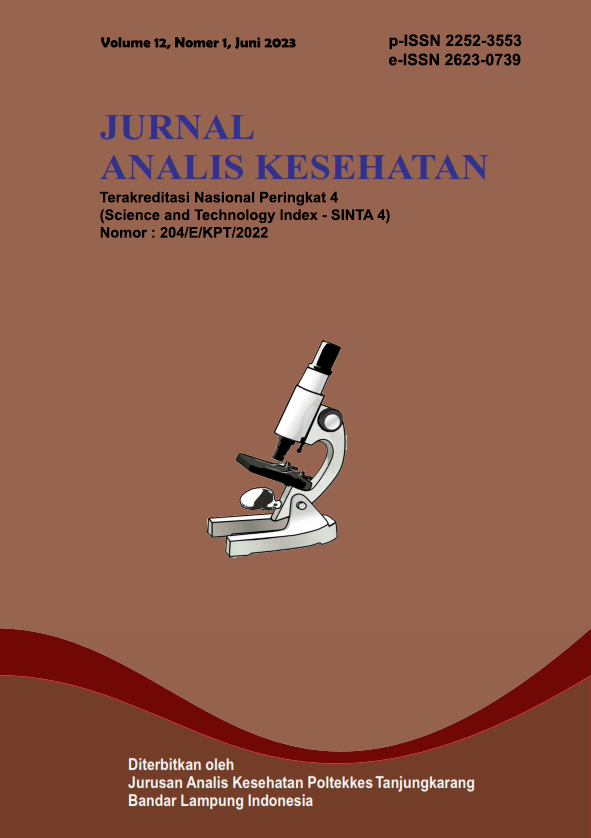Uji Toksisitas dan Aktivitas Antimalaria Melalui Penghambatan Polimerisasi Hem Fraksi Etil Asetat, N-Heksan dan
DOI:
https://doi.org/10.26630/jak.v12i1.3831Keywords:
Haem polymerization, Antimalarial, Bidara leaf, ToxicityAbstract
The population at risk of developing malaria in the Asian region is 1.4 billion people. Nine countries are at high risk of developing malaria in the Asian region where the highest proportion is achieved by India 89%, Myanmar 2% and Indonesia 7%. Inhibition of heme polymerization is an initial screening test for antimalarial activity. Bidara leaves (Ziziphus mauritiana L.) were selected based on the content of secondary metabolites containing alkaloids. Plant compounds that have been shown to have heme polymerization inhibitory activity are phenolic compounds such as flavonoids, anthraquinones, tannins, saponins, terpenoids, alkaloids, and glycosides. This study aims to determine the chemical content and inhibition activity of heme polymerization based on the IC50 value of the N Hexane, Ethyl Acetate and ethanol fractions of bidara leaves (Ziziphus mauritiana L.). The research method was carried out using the modified Basilico method. Heme polymerization inhibition activity is expressed in 50% Inhibition Concentration (IC50), which is the extract level that can inhibit heme polymerization up to 50%. IC50 data showed that the lowest average IC50 value of the ethyl acetate fraction was 1.107 mg/mL, which means that the ethyl acetate fraction of bidara leaves with a concentration of 1.107 mg/mL could provide 50% inhibition. Followed by an average IC50 of the N Hexane fraction of 3.052 mg/mL and an average IC50 value of chloroquine diphosphate of 8.059 mg/mL. Meanwhile, the ethanol fraction of bidara leaves has an IC50 value above the positive control, which is 21.815 mg/ml.References
Basilico,N.,E.Pagani,D.Monti,P.Olliaro,&D.Taramelli.1998. A Microtitre based Method for Measuring The Haem Polymerization Inhibitory Activity (HPIA) of Antimalarial Drugs. Journal of Antimicrobial Chemotherapy.42:55-60.
Bero J, Frederich M, Quetin-Leclercq J. 2009. Antimalarial compounds isolated from plants used in traditional medicine. Journal of Pharmacy and Pharmacology. 61:1401-1433.
Huda M, Marhamah. 2022, Edukasi Pencegahan Malaria Dan Pemantauan Anemia Serta Usaha Pencegahan Penularan Covid-19 Pada Masyarakat Di Wilayah Kerja Puskesmas Sukamaju Teluk Betung, Jurnal Kreativitas Pengabdian Kepada Masyarakat (Pkm) P-ISSN: 2615-0921 E-ISSN: 2622- 6030 Vol 5 [10 OKTOBER 2022] Hal 3262-3275
Huy NT, Uyen DT, Maeda A, Trang DTX, Oida T, Harada S, et al. 2007. Simple colorimetric inhibition assay of heme crystallization for high-throughput screening of antimalarial compounds. Antimicrob Agents Chemother. 51:350-3
Kementerian Kesehatan RI. 2021. Fakta keberhasilan pengendalian malaria. Jakarta: Ditjen Pencegahan dan Pengendalian Penyakit Kemenkes RI
Kaur, R., Kapoor, K., and Kaur, H. 2011. Plants as a source of anticancer agents. Plant Resour J Nat Prod. 1 : 119–24. CT Institute of Pharmaceutical Sciences Jalandhar, India.
Kusriani, R.H., Nawawi, A., dan Machter, E. 2015. Penetapan Kadar Senyawa Fenolat Total dan Aktivitas Antioksidan Ekstrak Daun, Buah dan Biji Bidara (Ziziphus spina christi L.).
Latiff, A.M., 1991. Ziziphus mauritiana Lamk. In: Verheij, E.W.M. and Coronel, R.E. (Editors). Plant Resources of South-East Asia No. 2: Edible fruits and nuts. Pudoc, Wageningen, The Netherlands, pp. 310-312.
Prior, R.L. 2013. Fruit and vegetable in The Prevention of Cellular Oksidative Damage. Am J Clin Nutr.
Saxena S, Pant N, Jain DC, Bhakuni RS. 2003. Antimalarial Agents from Plant Sources. Current Science. Vol 8 (9):1314-132
Septiana AT, Asnani A. 2013. Aktivitas antioksidan ekstrak rumput laut Sargasum duplicatum. Jurnal Teknologi Pertanian. 14(2):79- 86.
Shahat, A.A., Pieters, L., Apers, S., Nazeif, N.M., Abdel-Azim, N.S., Vanden Berghe, and D., Vlietinck, A.J. 2001. Chemical and biological investigations on Zizyphus spina-christi L.Phytother Res 15(7): 593-597
Sudarmadji S, Haryono B, Suhardi. 1989. Analisa bahan makanan dan pertanian. Jogjakarta: Liberty
Tschesche, R., Elgamal, M., Miana, G. A., and Eckhardt, G. 1975. Alkaloids from rhamnaceae-XXVI. Nummularine-D, -E and -F, new cyclopeptide alkaloids from Ziziphus nummularia. Tetrahedron 31(23): 2944-2947.
Utamiwati, N.P.M. 2018. Identifikasi Komponen Fitokimia Ekstrak Bidara (Ziziphus Mauritiana L.). NTT : Stikes Citra Husada Mandiri Kupang.
Wahyono, Pudjon; P. Widyati. 2010. Uji Aktivitas Senyawa Anti Plasmodium dari Fungi Endofit Tanaman Artemsia annua L. Majalah Farmasi Indonesia. 21: 230-235.
WHO, 2021. Word Malaria Report. Creatif Commons attribution. Cape Town https://www.who.int/teams/global-malaria-programme/reports/world malaria-report-2021. 31 Oktober 2022 14.06 WIB.
Ye, Z., Dykel, K.V., Castranova, V., 1989. The potentiating action of tetrandine in combination with chloroquine or qinghaosu against chloroquine sensitive and resistant falciparum malaria, Biochem. Biophys. Re. Comm. 159 (1), 242-247.1277088, PMID 16270941.
Downloads
Published
Issue
Section
License

Jurnal Analisis Kesehatan is licensed under a Creative Commons Attribution-ShareAlike 4.0 International License.
Based on a work at https://ejurnal.poltekkes-tjk.ac.id/index.php/JANALISKES.








